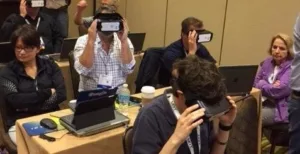The annual Future of Education Technology Conference (FETC 2017), held each year in Orlando, Florida sets the tone and previews what’s up and coming for educational technology in the U.S. This year, one of the big surprises at FETC involved the growth and developing maturity of the virtual reality phenomenon in education.
Opening Keynote Rarely in education conferences are 3D or virtual reality speakers a mainstay of these opening acts. In the case of FETC 2017, two of the four selected keynote speakers for the “Awesome New Technologies” kick-off event addressed virtual reality implementations.
The first speaker was Dan Lejerskar, Chairman of Eon Reality, who spoke about the budding interest in VR content generation by noting the ability of users to build their own VR modules in education from a library of 8,000 existing building blocks. He also touted his product’s ability to pin annotations and interactions on existing VR content, without needing programming knowledge. A second speaker, Hall Davidson of Discovery Education, highlighted a new type of digital text, “a reinvention of the textbook”, now under development in Discovery Education that enabled the embedding of interactive objects and assessment questions within existing virtual reality media. He also announced ThingLink VR integration within the product.
FETC Sessions
Besides the strongest presence for VR ever seen in the exhibit hall, a number of clever companies reached out to the general conference sessions in innovative ways:
Instead of exhibiting in the expo, Samsung shaped their own presence by offering three well-attended power workshops away far away from the cacophony of the expo hall. These sessions featured dozens of small companies now offering educational VR content as well as content creation resources. (For example, the new Bubbli group was a delightful surprise for those interested in easy 360° spherical content creation.)
EonReality leveraged the student-content creation theme to present “Do it Yourself Virtual Reality Content Creation: Learn by Doing” and to push their new AVR tool.
zSpace teamed powerfully with a research effort at North Carolina State University in presenting “Virtual Reality STEAM Changes Student Outcomes.”
Virtual Reality also pursued “pop star” status in Kathy Shrock’s “Virtual Reality: Using and Creating in the Classroom” as well as two teacher presentations by Google’s educator minions: “Google Cardboard: Bring the World to Your Classroom” and “Explore with Google Expeditions.”
In addition, three sessions provided additional connections and excitement with VR in their presentations, including “Classrooms of the Future: Persuasive Technologies for Online Leaners”, “Three Augmented Reality and One Virtual reality STEM solution That Will Not Break Your Bank”, and “Big New “Rs” in Education: AR & VR”.
Samsung’s VR in the Classroom Workshop at FETC (above).
Samsung’s Shari Sentlowitz presenting (below).
My Presentations
Of course, I not only attended this event, I also presented.
My FETC 3D VR workshop helped feed hungry educators a more rounded diet of in-depth VR teaching strategies and practices than most of the post-truth hype they have experienced to date.
My session on See2Achieve: Virtual Reality 3D, Vision Learning and Reading made the exciting connections between vision health, VR, and the ability to read at the primary level—all good news for children in classrooms. On a related note, there might be a ‘dumpster fire’ in the making over the visual demands of VR on children. A representative from the early childhood think tank, the Erikson Institute came to my session, interested in revisiting the excessive screen time debate in the context of VR.
A Balcony View
At this year’s FETC conference, a number of mature VR idea strains emerged, echoing repeatedly from session to session, whether formally or informally debated:
Wrestling with definitions of VR. VR still means too many things to too many people. To some, spherical photography is VR; to others, it’s 360° video. And to others, it’s immersive virtual worlds or simulations. Customers remain confused at best, uniformed at worst.
Beyond an inch deep. Educators everywhere—especially those attending my workshops—are tired of the hyperbole and the inch-deep insight that they currently receive about VR at ed-tech conference presentations. They crave deeper understanding and more details on managing, teaching, and creating/purchasing content with VR. They are demanding better answers to the tough questions.
Lots of players moving into this space. The number of educational content producers being identified at conference sessions seems to be expanding exponentially. Big publishers are also taking a back seat to the uberization of content. At the same time, busy educators are starting to recognize the need for better curation of the rising flood of educational VR resources.
High interest in educational user-content creation. This topic simply won’t go away. This represents a significant threat to the nascent VR software industry. Emerging VR content producers need to be smart, agile, and perceptive or their market will be taken away—by students. Mike drop.
Interactivity: the holy grail. Every educator with whom I speak wants more interactivity built into educational VR experiences. No more interactivity ‘light’, such as interactive links, glaze navigation, and dashboard option selection. No, they want real-rich-compelling educational interactivity.
Increasing skepticism. Educational ICT purchasers, especially those with deep institutional pockets, remain wary of the ability of VR technology “to scale, to service large class sizes, and to remain cost-effective” in doing so.
–Len Scrogan

